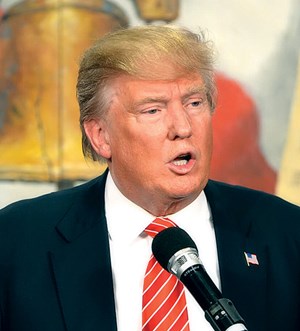Presidential nominees’ energy policies can potentially impact U.S. upstream industry
The 2016 U.S. presidential election will be historically significant, and it may have some unpredictable consequences. However, U.S. post-election policy for the oil and gas (O&G) industry is more predictable, as seen from the platforms and plans of the presidential candidates.
HILLARY CLINTON
Democratic presidential nominee Hillary Clinton advocates energy and environmental policies that are anathemas to the O&G industry. For example, she:
- Supports aggressive global warming policies and regulations, and the recent Paris climate agreement.
- Opposes offshore, Arctic drilling.
- Supports banning crude oil exports.
- Opposes the Keystone XL pipeline.
- Favors increased pipeline and rail regulations.
- Supports carbon regulations/taxes.
- Will cut the “billions of wasteful tax subsidies (that) oil and gas companies have enjoyed for too long.”
- Would rapidly phase out fossil fuels.
- Endorses increased tax incentives, mandates for renewable energy (RE).
- Endorses increased EPA regulation of the energy industries.
Clinton announced that, as President, she would negotiate a North American Climate Compact between the U.S., Canada and Mexico, to create national mandates for emissions reductions in each country. In addition, she would develop common infrastructure standards; expand regional emissions trading markets; invest in low-carbon transportation; and set methane reduction standards.
Clinton’s detailed climate plan recommends, among other things, installation of 500 million solar panels by 2021—a 700% increase over current installations, and a goal that the U.S. will generate enough RE to power every home in America within 10 years of her taking office. Her energy policy is essentially a climate change and RE policy that gives short shrift to O&G, and assigns coal to the dustbin. It thus discards the “all of the above” energy policy that was in the 2012 Democratic platform, which recommended developing all U.S. energy resources, including wind, solar, biofuels, geothermal, nuclear, oil, clean coal, and natural gas. In 2016, this “all of the above” policy was removed from a draft of the Democratic National Committee platform, under pressure from activists and environmental groups.
The Clinton plan opposes efforts to roll back the Clean Power Plan (CPP), and she would defend it fiercely. Clinton would:
- Establish a Climate Action Competition, to empower states to exceed federal carbon standards and accelerate clean energy deployment.
- Create a Solar X-Prize for communities that cut red tape that slows rooftop solar installation times.
- Ensure that federal officials help Americans build a clean energy future.
- Overcome barriers that prevent households from using solar energy.
- Expand RE on public lands, federal buildings, and federally-funded infrastructure.
- Increase public investment in clean energy R&D.
Clinton’s natural gas message is mixed. She advocates switching from coal to natural gas for reducing CO2 emissions under the CPP, and contends that gas-fired combined cycle plants can improve grid reliability and enable greater integration of RE. She also would accelerate the deployment of gas-fueled trucks, buses, ships and trains. However, her long-term plan would “ultimately require replacing conventional natural gas with lower-carbon alternatives.”
Further, as President, Clinton pledges to ensure that gas production is safe and responsible. She thus proposes to:
- Control fugitive methane emissions and achieve President Obama’s goal of reducing methane emissions 40%–45%.
- Protect local water supplies; eliminate the “Halliburton loophole” in the Safe Drinking Water Act; require that companies disclose the chemicals they use in fracing; ensure that robust well casing requirements exist; and improve wastewater recycling and disposal.
- Prevent induced seismic activity, and ensure that systems and permitting procedures are in place to avoid potential, induced seismic activity.
Clinton succinctly expressed her objective for coal during a May 2016 Democratic town hall event in Ohio, when she stated that she wants to move away from using coal as an energy source—even if it means eliminating jobs. She said, “We’re going to put a lot of coal miners and coal companies out of business.”
DONALD TRUMP
Republican presidential nominee Donald Trump’s energy platform is almost a mirror image of Clinton’s. Trump released his “An America First Energy Plan,” in a May 2016 speech in North Dakota. As President, Trump would approve the Keystone XL pipeline, stating that it would create and support more than 42,000 jobs, and not impact the environment significantly. He pointed out that Obama’s State Department concluded that it would be the safest pipeline ever built in the U.S.
Trump’s energy plan will “make America wealthy again, and American energy dominance will be declared a strategic economic and foreign policy goal of the United States.” Trump stated, “We will become, and stay, totally independent of any need to import energy from the OPEC cartel or any nations hostile to our interests. At the same time, we will work with our Gulf allies to develop a positive energy relationship as part of our anti-terrorism strategy. We will use the revenues from energy production to rebuild our roads, schools, bridges and public infrastructure. Cheaper energy will also boost American agriculture. We will get the bureaucracy out of the way of innovation, so we can pursue all forms of energy.”
A Trump administration “will focus on real environmental challenges, not phony ones: We will reject Hillary Clinton’s poverty-expansion agenda that enriches her friends and makes everyone else poor. We’ll solve real environmental problems in our communities, like the need for clean and safe drinking water. American workers will be the ones building this new infrastructure.”
Trump’s 100-day action plan would:
- Rescind all of Obama’s executive actions, including the CPP and the Waters of the U.S. rule.
- Ask TransCanada to renew its permit application for the Keystone XL Pipeline.
- Lift moratoriums on energy production in federal areas.
- Revoke policies that impose restrictions on new drilling technologies.
- Cancel the Paris Climate Agreement and stop all payments of U.S. tax dollars to UN global warming programs.
- Scrap any regulation that is outdated, unnecessary, bad for workers, or contrary to the national interest
- Save the coal industry and other industries.
- Eliminate duplication, provide regulatory certainty, and trust local officials and residents.
- Subject any future regulation to a simple test: Is this regulation good for the American worker? If not, the rule will not be approved.
- Ensure that policy decisions are public and transparent.
Trump promised to do all this while showing proper regard for rational environmental concerns, and he will “conserve our beautiful natural habitats, reserves and resources.” In a Trump administration, “political activists with extreme agendas will no longer write the rules… My America First energy plan will do for the American people what Hillary Clinton will never do: create real jobs and real wage growth.”
He contends that his agenda will be accomplished through a series of “America first” reforms, and stated that his energy reforms will create trillions in new wealth. Lifting the restrictions on American energy will create a flood of new jobs, increase annual economic output over the next 30 years by nearly $700 billion; and increase annual wages by more than $30 billion over the next seven years.
In his May speech, Mr. Trump stated, “Regulations that shut down hundreds of coal-fired power plants and block the construction of new ones—how stupid is that?”
CRUCIAL SENATE RACES
Control of the House of Representatives in 2016 is unlikely to be in question, since the Democrats need a net gain of 30 seats, which is nearly impossible. If Clinton wins the presidential race, then control of the Senate will be of special concern to the O&G industry.
The Senate has 54 Republicans and 44 Democrats. Two independents caucus with the Democrats, which effectively gives them control of 46 seats. To control the Senate, Democrats need to gain five seats—four if they win the presidential race, since the Vice President breaks tie votes in the Senate.
The Democrats have only 10 seats to defend, while the Republicans have 24. The majority of vulnerable seats are held by Republican incumbents, many of whom are freshmen elected in 2010. The one competitive seat held by a Democrat is in Nevada where Senator Harry Reid is retiring, and the race is rated as a toss-up. Of the 24 Republican seats, at least nine are rated as toss-ups: Florida, Illinois, Indiana, Missouri, New Hampshire, North Carolina, Ohio, Pennsylvania and Wisconsin.
Republicans attempting to maintain control of the Senate face other headwinds. For example, 2016 is a presidential election year, and this usually works to the advantage of Democrats. Presidential elections generate high voter turnout, especially among Democratic constituencies. Further, Donald Trump has thrown the Republican Party into chaos, alienated key constituencies while running a sometimes sub-par campaign.
Control of the Senate could still tip in either direction. However, the best the Republicans can probably hope for is to retain a small majority or a tie. Political analysts and forecasters currently give the Democrats a 50%–50% chance of gaining control of the Senate. This may have ominous implications for the O&G industry, especially if Clinton is victorious. ![]()

- Applying ultra-deep LWD resistivity technology successfully in a SAGD operation (May 2019)
- Adoption of wireless intelligent completions advances (May 2019)
- Majors double down as takeaway crunch eases (April 2019)
- What’s new in well logging and formation evaluation (April 2019)
- Qualification of a 20,000-psi subsea BOP: A collaborative approach (February 2019)
- ConocoPhillips’ Greg Leveille sees rapid trajectory of technical advancement continuing (February 2019)




